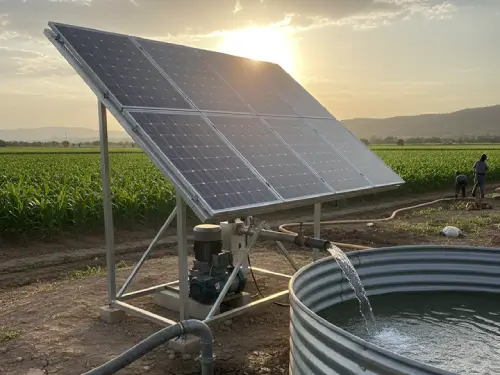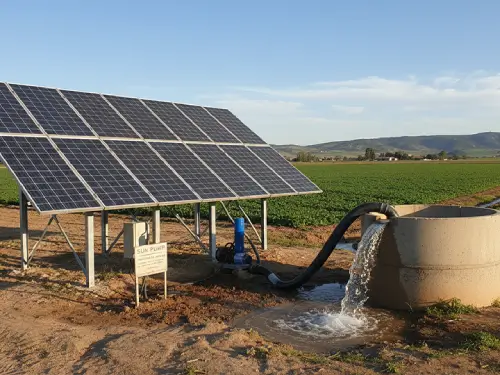A solar panel water pump is a pumping system powered by solar energy rather than electricity or gas. It absorbs sunlight through solar panels (photovoltaic) and converts this energy to pump water for irrigation, livestock, or domestic purposes.
In India, solar pumps are increasingly adopted by farmers, rural residents, and community projects because they reduce dependence on the grid, high fuel costs, and the challenges of fuel supply. Farmers and homeowners see solar pumps as a reliable, renewable option for water supply in remote areas, and many can benefit from government subsidies to reduce their upfront cost.
Key Summary
How a Solar Pump Works
The solar pump working principle is based on converting sunlight into usable electricity. Solar photovoltaic (PV) panels capture solar energy and generate direct current (DC) electricity. This electricity powers the motor, which drives the pump to lift or push water from the source (borewell, river, or tank) to the desired location.
In some systems, an inverter is used to convert DC into alternating current (AC) for pumps that require AC motors. The controller gives smooth operation, preventing overvoltage or dry running.
Step-by-Step Working Mechanism:
Benefits of Solar Pumps
When comparing a solar pump vs a traditional pump, solar-powered pumps offer multiple long-term advantages compared to traditional pumps. Here are the key benefits:
Types of Solar Water Pumps
Solar water pumps are eco-friendly and efficient systems designed to supply water using renewable solar energy. They are particularly useful in rural, remote, and agricultural areas where diesel or electricity-powered pumps are expensive and unreliable. Each type of solar pump has a specific design suited to different water depths, applications, and energy needs.
Here are the main types of solar water pumps:
1. Submersible Solar Water Pumps:
A submersible solar pump is installed underwater, usually inside a borehole or deep well. Instead of pulling water like surface pumps, it pushes water upward from depths greater than 10 meters. These pumps are commonly used in agriculture where groundwater tables are low or in regions where consistent deep water extraction is necessary.
Best For: Deep wells and boreholes
| Advantages | Disadvantages |
|---|---|
| Highly efficient for extracting water from deep sources. | Higher cost due to complex installation. |
| Works in areas far from the electricity supply. | Requires regular maintenance to avoid clogging from sand or mineral deposits. |
| Available in both DC and AC motor options. | Difficult to access and repair once installed underwater. |
2. Surface Solar Water Pumps:
A surface solar pump is placed above ground and draws water from shallow sources such as rivers, ponds, lakes, or storage tanks. It works best when water levels are close to the surface and is widely used for small farms, fish farming, livestock watering, and household water supply.
Best For: Shallow water sources (less than 10 meters)
| Advantages | Disadvantages |
|---|---|
| Easy to install and maintain. | Not effective for deep wells. |
| Cost-effective for shallow water extraction. | May require additional piping for long-distance water transport. |
| Ideal for gardens, irrigation setups, and livestock. | Efficiency may drop during low water levels or in dry seasons. |
3. DC Solar Water Pumps:
A DC solar water pump runs directly on electricity generated by solar panels. Since it does not need an inverter, it is a simple, low-maintenance, and cost-efficient solution for areas that are not connected to the power grid. These pumps are commonly used in domestic water supply, livestock watering, and small-area irrigation.
Best For: Small-scale and off-grid applications
| Advantages | Disadvantages |
|---|---|
| No inverter is required, which helps reduce energy loss. | Limited pumping capacity. |
| It has a simple design, resulting in low maintenance and operating costs. | Scaling up requires additional panels, which increases cost. |
| Perfect for remote and rural areas. | Not suitable for heavy-duty or large-volume water applications. |
4. AC Solar Water Pumps:
An AC solar water pump uses an inverter to convert the DC power from solar panels into AC power. This makes it compatible with conventional AC-powered water pumping systems, allowing farmers or industries to upgrade existing setups to solar without replacing the pump motor. They are ideal for large-scale irrigation, deep borewells, and industrial water needs.
Best For: Large-scale irrigation and industrial applications
| Advantages | Disadvantages |
|---|---|
| Stronger output suitable for high water demand. | Higher initial cost due to the inverter. |
| Can connect to the grid for continuous use. | Slightly more complex setup and servicing. |
| Suitable for deep groundwater pumping. | Power loss may occur during DC-to-AC conversion. |
5. Hybrid Solar Water Pumps:
A hybrid solar water pump combines solar power with an alternate energy source, such as grid electricity or a diesel generator. This gives an uninterrupted water supply even during cloudy days or at night. Hybrid pumps are a popular choice for large farms, commercial irrigation, and industrial projects where water demand is high and consistent operation is critical.
Best For: Areas with inconsistent sunlight and backup needs
| Advantages | Disadvantages |
|---|---|
| Reliable supply even during low sunlight. | Expensive compared to standard solar pumps. |
| Flexible power options reduce downtime. | Requires additional wiring and system components. |
Solar Pump Installation and Maintenance Tips
Solar pump installation starts with choosing a sunny, unobstructed site for the solar panels. The pump is then placed in the water source, submersible pumps for deep wells and surface pumps for shallow sources. Panels are connected to the pump, with an optional battery backup for extended use. Proper piping and secure fittings help in smooth water flow. To maintain efficiency and extend lifespan, regular care like cleaning panels and checking for blockages is essential.
Here are the main types of solar water pumps:
Installing a solar water pump system requires careful planning and proper execution for long-term performance. Below are the standard steps involved:
Once commissioned, the solar pump will operate automatically whenever sunlight is available, without the need for manual intervention.
Operation and Maintenance
Solar pumps are low-maintenance compared to traditional diesel or electric pumps, but regular upkeep can result in a lifespan of 15+ years.
Follow these tips:


How Much Does a Solar Pump Cost?
The cost of a solar pump depends on several factors, including its horsepower, type (AC or DC), application (surface or submersible), and system design. Prices can range from around ₹25,000 for a small 0.5 HP pump to over ₹5 lakh for a 10 HP system. While the initial investment may seem significant, government subsidies, brand, and configuration choices can influence the final cost.
Typical Price Ranges:
Factors Influencing Solar Pump Costs:
Choosing the Right Solar Pump
Selecting the right solar water pump requires careful evaluation of factors such as source depth, water demand, sunlight availability, budget, and power backup options. Each of these plays a role in ensuring efficiency and cost-effectiveness.
1. Source Depth
The depth of your water source largely determines the type of pump you’ll need. Where water lies deeper than 10 meters, submersible solar pumps are most effective since they work underwater and push water to the surface. On the other hand, for shallow sources with depths less than 10 meters, surface solar pumps are a better choice as they operate above ground and draw water directly. Choosing the correct type gives maximum performance with minimal energy use.
2. Water Demand
Another major factor is the daily water requirement. By matching pump size to your actual demand, you avoid unnecessary energy waste while ensuring a consistent water supply.
3. Sunlight Availability
Since solar pumps rely on sunlight, local climatic conditions directly affect their performance. In regions with consistent sunlight, solar pumps can run smoothly throughout the day. In areas prone to cloudy weather or reduced sunlight, a hybrid solar pump is a better option, as it can switch to grid electricity or even a diesel generator when solar power falls short. This flexibility guarantees a steady water output regardless of weather changes.
4. Budget and Cost Efficiency
Budget is often the deciding factor, but it should be balanced against long-term benefits. Surface and DC solar pumps generally have lower upfront costs and are easier to install, making them suitable for smaller projects. In contrast, submersible pumps, AC pumps, and hybrids require a higher initial investment but offer greater durability, efficiency, and long-term savings by reducing electricity or fuel costs. Consulting trusted solar pump manufacturers in India can also help you find the right balance between price, performance, and reliability for your specific application.
5. Power Supply Availability
Finally, think about the backup power options in your area. For off-grid locations, a well-sized DC or AC solar pump powered purely by solar panels is sufficient. However, if your area experiences frequent power outages or requires an uninterrupted water supply, hybrid solar pumps are more reliable. They allow seamless switching between solar energy, grid electricity, or a generator, ensuring you never face downtime.
FREE SOLAR EXPERT CONSULTATION
Conclusion
Solar water pumps are rapidly changing the way water is sourced for agriculture, households, and industries across India. They offer a cleaner, cost-effective, and highly reliable alternative to traditional pumps, especially in rural and off-grid areas. By considering factors such as source depth, water demand, budget, and sunlight availability, users can select the pump type that delivers maximum efficiency and long-term savings. Many farmers and businesses are now turning to trusted providers like Alpex Solar for quality systems, innovative technology, and subsidy support that reduces the upfront investment. Choosing the right partner helps in efficient installation and also dependable performance for years to come.




